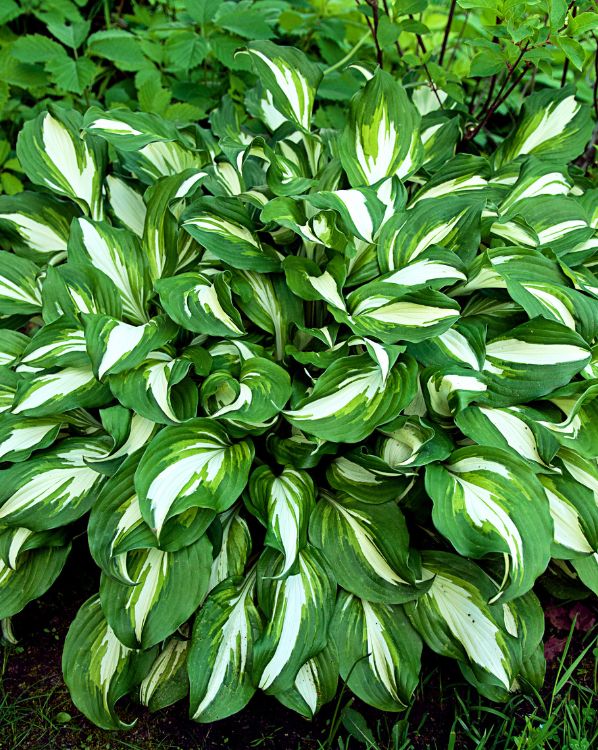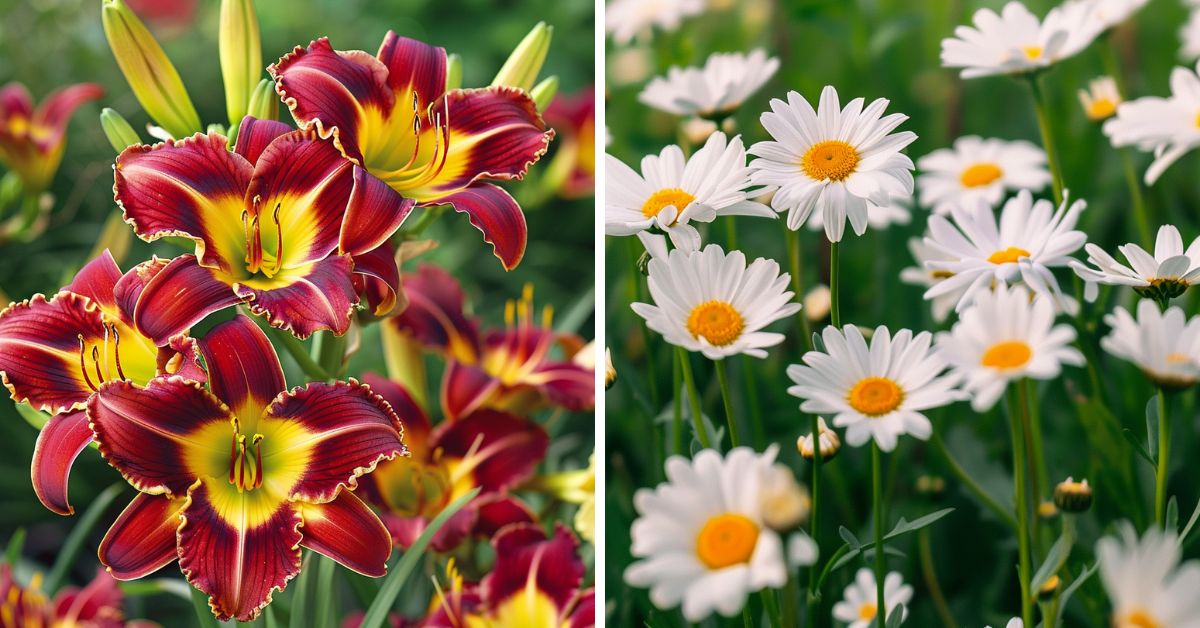Daylilies are a favorite in many gardens, including my own.
Their vibrant colors and hardy nature make them a joy to grow, and they bloom for much of the summer.
But like many gardeners, I’ve discovered that daylilies truly shine when paired with the right companion plants.
The key is to choose plants that complement their height, colors, and bloom times, or that provide a different texture to keep your garden visually interesting throughout the season.
Over the years, I’ve experimented with a wide range of companion plants for my daylilies, and I’m excited to share my 14 best choices with you.
These plants will not only enhance the beauty of your daylilies but will also bring balance and variety to your garden.
1. Echinacea (Coneflower)

Echinacea, or coneflower, is a perfect companion for daylilies.
Its daisy-like blooms, which appear in midsummer, add a different shape and texture to the garden that contrasts nicely with the arching stems and trumpet-shaped flowers of daylilies.
In my experience, planting purple or pink echinacea alongside yellow or orange daylilies creates a stunning color contrast that draws the eye.
Echinacea is also drought-tolerant and attracts pollinators like bees and butterflies, making it a practical and beautiful addition to any daylily bed.
Together, these plants create a dynamic pairing that blooms at the same time, ensuring a colorful display all season long.
2. Rudbeckia (Black-Eyed Susan)

Rudbeckia, commonly known as black-eyed Susan, is another fantastic companion for daylilies.
These bright, cheerful flowers bloom from mid-summer into fall, extending the color in your garden long after some other plants have finished their display.
What I love about rudbeckia is how its golden yellow petals seem to echo the sunshine hues of daylilies, while its dark centers provide a bold contrast.
I’ve planted rudbeckia at the back of my daylily beds, where their upright growth habit helps to create layers and depth.
Both plants thrive in full sun and are relatively drought-tolerant, making them easy to care for when planted together.
3. Salvia

Salvia’s tall, spiky blooms provide an excellent vertical contrast to the more rounded form of daylilies.
Its purple or blue flowers bring cool tones into a garden that might be filled with the warmer shades of daylilies, creating balance and variety.
In my garden, I love how salvia’s blooms continue long after the first flush of daylilies has faded, keeping the flower bed looking fresh and full of life.
The bonus with salvia is that it attracts pollinators like bees and butterflies while deterring pests like aphids, making it a valuable addition to any garden.
Together, salvia and daylilies create a complementary partnership that’s both visually stunning and low-maintenance.
4. Nepeta (Catmint)

Nepeta, or catmint, is another excellent companion for daylilies.
With its low-growing, billowy habit and soft lavender-blue flowers, nepeta creates a lush groundcover that fills in the space around daylilies without competing for attention.
In my experience, nepeta’s silvery-green foliage contrasts beautifully with the rich greens of daylily leaves, creating a layered look that adds depth and texture to the garden.
Plus, nepeta is incredibly drought-tolerant and thrives in full sun, just like daylilies.
I’ve found that planting nepeta at the front of my daylily beds helps soften the edges and create a cohesive, flowing look.
5. Shasta Daisy

Shasta daisies are a classic choice for any garden, and they pair beautifully with daylilies.
Their bright white petals and yellow centers provide a crisp, clean contrast to the more saturated colors of daylilies, creating a cheerful, eye-catching display.
I love planting Shasta daisies in the middle of my daylily beds, where their upright growth habit adds height without overshadowing the daylilies.
Shasta daisies are also incredibly easy to grow and will bloom for much of the summer, extending the period of interest in your garden.
Together, daylilies and Shasta daisies create a classic, timeless combination that’s hard to beat.
6. Hemerocallis (Stella de Oro)

While it might seem counterintuitive, planting different varieties of daylilies together can create a stunning display.
One of my favorite combinations is pairing the compact “Stella de Oro” daylily with larger varieties.
The continuous blooming habit of “Stella de Oro” means that even after other daylilies have finished their show, this variety keeps the garden filled with color.
In my garden, I’ve planted “Stella de Oro” in front of taller daylily varieties, creating a layered effect that ensures continuous blooms from early summer into fall.
It’s a simple way to maximize the impact of daylilies in your garden without adding too many different types of plants.
7. Russian Sage (Perovskia atriplicifolia)

Russian sage is a tall, airy plant with silvery foliage and spires of lavender-blue flowers.
It pairs beautifully with daylilies, adding both height and texture to the garden.
I love the way the cool tones of Russian sage contrast with the warmer hues of daylilies, creating a harmonious yet dynamic display.
In my garden, I’ve found that Russian sage’s long blooming period keeps the garden looking fresh even after the daylilies have started to fade.
Plus, Russian sage is drought-tolerant and thrives in hot, sunny conditions, making it a perfect companion for daylilies that require similar care.
8. Sedum (Stonecrop)

Sedum is a low-growing succulent that makes a great companion for daylilies, especially in hot, dry areas.
Its fleshy leaves provide a completely different texture, and its late-blooming flowers bring a new layer of interest to the garden after the daylilies have finished their display.
I’ve planted sedum along the edges of my daylily beds, where its low profile creates a clean, finished look.
Sedum’s ability to tolerate drought and poor soil makes it a perfect low-maintenance companion, and its blooms attract butterflies and other pollinators, enhancing the overall health of the garden.
9. Ornamental Grasses

Ornamental grasses, like fountain grass or switchgrass, make excellent companions for daylilies, adding movement and texture to the garden.
The soft, swaying foliage of ornamental grasses creates a wonderful contrast to the more structured leaves and flowers of daylilies.
In my garden, I’ve planted fountain grass behind my daylilies, and I love the way the tall, feathery plumes rise above the daylily blooms, creating a layered, dynamic look.
Ornamental grasses are also incredibly easy to care for, thriving in full sun and well-drained soil, just like daylilies.
Together, these plants create a natural, relaxed garden that feels full and alive.
10. Phlox

Phlox is a fantastic companion for daylilies, offering a long season of bloom and a wide range of colors.
The tall, upright flower clusters of phlox contrast nicely with the more compact blooms of daylilies, adding height and interest to the garden.
In my garden, I’ve planted pink and purple phlox varieties alongside orange and red daylilies, and the result is a vibrant, colorful display that lasts well into late summer.
Phlox also attracts butterflies and hummingbirds, adding another layer of beauty to the garden.
Both plants thrive in full sun and well-drained soil, making them a natural pairing for a low-maintenance garden.
11. Bee Balm (Monarda)

Bee balm is another pollinator-friendly plant that pairs beautifully with daylilies.
Its bold, spiky flowers come in shades of red, pink, and purple, creating a striking contrast to the more refined, trumpet-shaped blooms of daylilies.
I’ve planted bee balm in the middle of my daylily beds, where its tall stems add height and its vibrant colors complement the daylilies perfectly.
Bee balm’s aromatic foliage also helps to deter pests, which can be a bonus when growing daylilies.
Plus, bee balm attracts bees, butterflies, and hummingbirds, ensuring that your garden is buzzing with activity all summer long.
12. Hosta

If you’re looking for a companion plant for daylilies in a partially shaded area, hostas are an excellent choice.
While daylilies prefer full sun, they can tolerate light shade, making them compatible with hostas in those tricky garden spots.
I’ve planted hostas at the back of my daylily beds, where their large, bold leaves provide a dramatic contrast to the more delicate daylily blooms.
The cool greens and blues of hosta foliage also create a beautiful backdrop for the warmer colors of daylilies, helping to balance the garden’s overall color palette.
Together, hostas and daylilies create a lush, layered garden that thrives even in less-than-ideal light conditions.
13. Gaura (Whirling Butterflies)

Gaura, also known as whirling butterflies, is a light, airy plant with delicate, butterfly-like flowers that flutter in the breeze.
Its loose, open habit pairs beautifully with the more structured form of daylilies, adding movement and a sense of lightness to the garden.
In my experience, planting gaura with daylilies creates a dynamic, balanced display that feels natural and effortless.
Gaura’s long blooming season means that even after the daylilies have finished their show, your garden will still be full of color and interest.
Both plants thrive in full sun and well-drained soil, making them easy to grow together.
14. Coral Bells (Heuchera)

Coral bells are one of my favorite foliage plants to pair with daylilies.
Their colorful, often ruffled leaves come in shades of burgundy, bronze, and lime green, providing a striking contrast to the long, slender leaves of daylilies.
I’ve planted coral bells at the front of my daylily beds, where their low-growing habit helps to define the edges of the garden while adding a pop of color.
Coral bells also produce delicate, bell-shaped flowers on tall stems, adding another layer of interest to the garden.
Both coral bells and daylilies thrive in similar conditions, making them a perfect pairing for a well-rounded, visually stunning garden.
Final Thoughts
Daylilies are a versatile and beautiful addition to any garden, but pairing them with the right companion plants can take your garden to the next level.
The 14 plants I’ve shared here have all proven to be excellent companions for daylilies in my own garden, offering complementary colors, textures, and blooming seasons that keep the garden looking fresh and vibrant throughout the summer.
Whether you’re looking for plants that add height, color contrast, or texture, these companion plants will help you create a garden that’s both harmonious and dynamic.
With a little planning and creativity, you can create a stunning daylily garden that’s full of life, color, and interest all season long.
Happy gardening!
